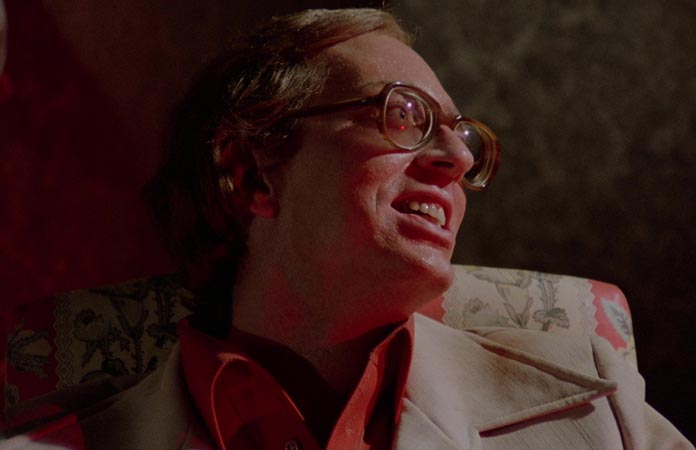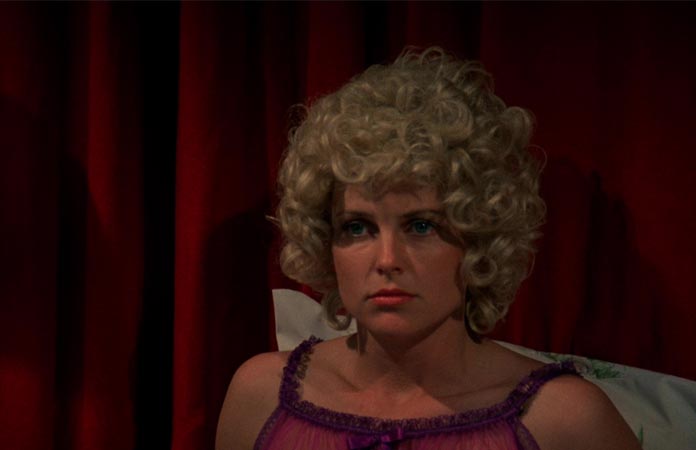Blu-Ray Review: Eaten Alive
Published on November 13th, 2015 in: Blu-Ray, DVD/Blu-Ray Reviews, Horror, Movie Reviews, Movies, Reissues, Retrovirus, Reviews |Tobe Hooper’s legendary status as a director began with The Texas Chain Saw Massacre in 1974. This gritty, grisly chunk of cinema has influenced countless films and spawned numerous imitators, including the entire subgenre known as “backwoods horror.” Hooper followed The Texas Chain Saw Massacre with 1976’s Eaten Alive; even those who worshipped at the previous film’s bloody, chicken-bone altar must have felt spiritually annihilated after enduring one of the most grueling film experiences in 1970s horror.
It’s not that Eaten Alive is as gory as say, your average Lucio Fulci film. It’s that it has a nasty, mean-spiritedness to it that prevents you from having much sympathy for anyone in the film, sort of like the feeling you get killing a wasp after it stings you. There’s certainly a lot of murdering in the movie, which should please the slasher fan contingent, yet the lack of exposition and a cohesive narrative is so discombobulating that after 90 minutes, you’d be forgiven if you needed a stiff drink. This isn’t to say Eaten Alive is a terrible movie; it’s a beautifully constructed movie that feels excessive yet under-realized.
The plot seems to be inspired by so many things that it becomes nearly irrelevant. Eaten Alive is based loosely on the legends of Texan war vet and saloon owner Joe Ball, who killed two women and eventually killed himself when he was caught in 1938. Like a lot of things in Texas, local folklore supersized Ball’s body count to the gruesome number of 20 and added in an apocryphal bit about how he fed his victims to the six alligators inhabiting the pond next to his saloon. Hence, his nickname: “The Alligator Killer.”
In Eaten Alive, Ball has been transformed into the decidedly unstable Judd, who owns the Starlite Motel. When shell-shocked would-be prostitute Clara wanders in looking for a room, Judd is kind to her until he figures out she’s one of Miss Hattie’s girls. Judd then kills her in a fit of rage and throws her half-dead body into the pond next to the hotel, which houses a giant beast he insists is a crocodile, a goofy-looking creature that’s the least-scary element of the movie. And she gets eaten alive. There’s more than a bit of Psycho to this story—not to mention Jaws—and the similarities multiply when Clara’s father and sister show up with a photo and ask Judd if he’s seen anyone who looks like the woman in it.
Why exactly is Judd crazy? It’s never explained, and that’s OK, but even a little bit more backstory might have helped Eaten Alive feel more compelling from a narrative standpoint. Judd has what looks like a Nazi flag in his bedroom and a wooden leg, both of which may or may not have been acquired during military service. PTSD certainly could be a factor, but a deeply repressed sexuality is definitely the main issue that seems to drive Judd’s homicidal rages.
After he dispatches Clara, Judd receives more guests at the Starlite. Faye and Roy, along with their daughter Angie and dog Snoopy have also stopped by. It doesn’t take long for Snoopy’s life to be snuffed out thanks to the crocodile, an event which sends Faye, Roy, and Angie into a panic and a room upstairs. This is the Manos: The Hands of Fate portion of Eaten Alive’s plot, only with more well-known actors: Marilyn Burns (Sally from Chain Saw), William Finley (Winslow from Phantom of the Paradise), and Kyle Richards (sister of actress/reality show star Kim). There’s definitely some crazy backstory implied because Roy behavior becomes increasingly erratic and Faye, for some reason, is wearing a wig to cover her long blonde hair.
Yet Eaten Alive has more killing in store, so we don’t get to find out the scoop on this fractured family. Plus, Judd has even more guests to see to, in the form of Buck and his underage girlfriend Lynette. Buck, played by an intensely rapey Robert Englund, is why Clara left in the first place. (She didn’t want to submit to the “fudge punch.”) The whole movie is about as confusing as your average giallo, which makes the ubiquitous red lighting and slowly rolling fog seem entirely appropriate.
Instead of a grainy depiction of a cannibalistic family gone wild, Eaten Alive looks and feels more like a Dario Argento film. The stunning transfer from Arrow reveals vivid, garish color and a convincing, theatrical soundstage for the Starlite, not to mention the brothel, a nearby pool hall, and the police department.
Other factors that distinguish Eaten Alive—besides a tone that consistently wallows in hallucinatory hysteria—are the score, soundtrack, and sound design. Not so much music as a series of weird noises that contrast to create an unsettling melody, the score is provided by Wayne Bell, who also worked on Chain Saw. It’s difficult to tell where sound effects end and the score begins. Judd’s mumbling and heavy breathing is mixed with Angie’s plaintive cries, plus the sound of bells, birds squawking, outdoor critters, and a series of synthesized screams that appear when no one is actually screaming. It’s one of the most uncomfortable and memorable scores I’ve ever heard, especially when paired with the lonesome and eerie country music that seems to be playing in every scene.
Overall, it’s easy to see why Eaten Alive may not have been received as well as The Texas Chain Saw Massacre. There are perhaps too many characters and story lines that aren’t fleshed out enough to hold everything together. In terms of visual and aural beauty, however, and the film’s ability to sustain an hour and a half of slowly increasing mania, it’s one of the most genuinely horrific horror films you’ll ever see.
As usual, Arrow Video’s reissue is packed with terrific extras, several of which have been brought over from the Dark Sky two-disc 2007 reissue. Besides an impressive number of trailers (red and green band) for the film’s various titles and a featurette about the real “Alligator Killer,” there are interviews with Tobe Hooper, Robert Englund, Marilyn Burns, and a commentary track with producer Mardi Rustam, make-up artist Craig Reardon, Roberta Collins, William Finley, and Kyle Richards. In addition there are tons of movie stills, new writing on the film, and newly commissioned artwork from the always amazing Gary Pullin.
Eaten Alive was released on September 22 from Arrow Video.


One Response to “Blu-Ray Review: Eaten Alive”
November 14th, 2015 at 3:21 pm
Shell-shocked would-be prostitutes! Super-sized body counts! ROBERT ENGLAND!!! This, I gotta see.
Time limit is exhausted. Please reload the CAPTCHA.